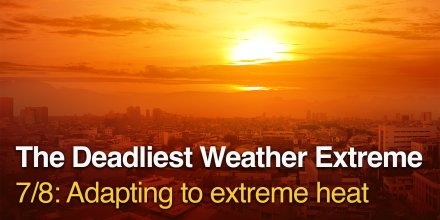This is a series of articles examining heatwaves from every angle, exploring their causes, consequences, and the science behind them. It includes eight parts:
- Introduction
- Heatwave patterns
- Health impacts
- Impacts on urban areas
- Extreme heat in 2024
- Are heatwaves linked to climate change?
- Adapting to more frequent periods of extreme heat
- Temperature, apparent temperature, and heat indices
Heatwaves are among the most dangerous natural meteorological phenomena. According to the IPCC, the number of people exposed to heatwaves will continue to rise as global temperatures increase. Unless adaptation measures are taken, the impacts of rising temperatures and more frequent heatwaves will continue to worsen.
In its Sixth Assessment Report, the IPCC outlines the following key findings on extreme heat and related heatwaves:
- The most vulnerable are those who have contributed least to climate change.
- Extreme heat and heatwaves increase the risk of food insecurity in vulnerable regions.
- Widespread declines in local plant and animal populations are linked to rising maximum temperatures and the occurrence of heatwaves.
- Rising temperatures and heatwaves increase illness and mortality. The impacts vary by age, gender, level of urbanization, and socioeconomic status. With high confidence, Central and South America, Southern Europe, South and Southeast Asia, and Africa are projected to be the most affected by climate-related heat mortality by 2100.
- Highly exposed groups include all outdoor workers, especially those engaged in manual labour (for example, in construction or agriculture). The number of work hours lost due to heat has risen significantly in the past two decades. Some regions are already experiencing levels of heat stress that approach or exceed human performance limits.
- In urban areas, heatwaves are intensified by the urban heat island effect.
- Rapid urbanization, lack of climate-sensitive planning, and ongoing urban heat island effects increase the vulnerability of marginalized urban communities and critical infrastructure to climate change.
- The occurrence of pests, weeds, and diseases is likely to increase with global warming. Extreme events such as droughts, floods, heatwaves, and wildfires will further amplify these impacts, with negative consequences for ecosystems, food security, human health, and livelihoods.
As climate change continues to worsen, the need for adaptation will become increasingly urgent. Mitigation strategies and adaptation measures are essential for protecting society as a whole.
Urban planning and the development of Heat Action Plans (HAPs) can play a key role, for example. These plans include measures across various timeframes, ranging from immediate responses to extreme heat, through seasonal preparedness, to long-term urban development strategies. While many cities in North America, Europe, Australia, and more recently India already have HAPs in place, they are largely lacking in Africa, the Middle East, South America, and small island states. The rapid growth of urban populations means these regions urgently need to strengthen their planning for extreme heat.
Warning systems also play a vital role by alerting residents to upcoming heatwaves and enabling them to take preventive measures. According to the United Nations, only 54% of national meteorological and hydrological services, that is, 104 institutions, issue warnings for extreme heat, significant heat stress on the human body, or heatwaves.
Heat has become a significant societal risk, and with ongoing climate change, its threat is expected to grow further, yet it often remains underestimated. Efforts to raise public awareness about the dangers of heatwaves, and to encourage government institutions to implement adaptation measures, have recently led to proposals suggesting that heatwaves should be named similarly to hurricanes.
Explore how our tools help you prepare for heatwaves: Urban Heat Maps offer hyper‑local temperature insights tailored to city planning and public health, climate+ provides long-term modelled and observed climate data for strategic adaptation, and point+ delivers precise, customisable weather forecasts for any location.
This article is based in part on original work provided by Jaroslava Sochorova (Windy.com), which has been adapted and edited by meteoblue.


